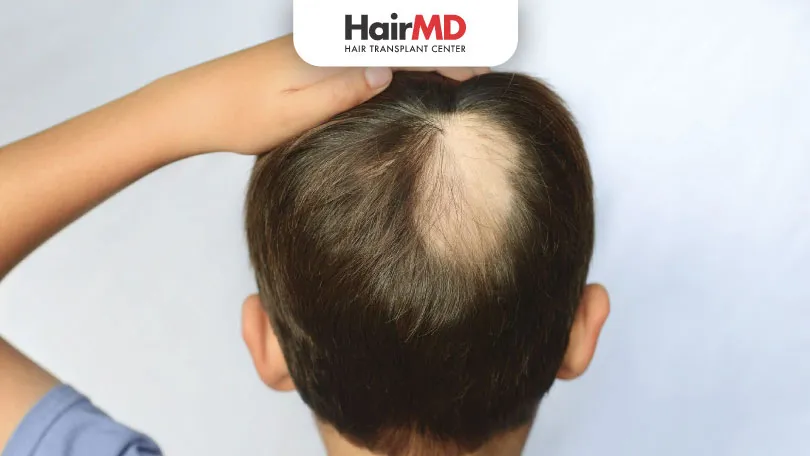19th August, 2021

Hair loss is an issue faced by adults and kids too. Almost 3% of pediatric office visits in India is because of hair loss.
As an adult, you are used to hair loss or thinning hair, but it can be a little frightening when you see it happening with your child. With timely diagnosis, the good news is that hair fall in kids can be treated with great success.
What’s covered in the article?
- What Causes Hairfall in Children?
- Are Some Kids More Likely to Get Bald Spots?
- How to Diagnose Hair Fall?
- Is Alopecia or Hair Fall in Children Permanent?
- How Can I Help my Child With Alopecia?
- Does It Indicate a Serious Underlying Problem?
- Mental Health Support for Kids With Alopecia
- Why choose HairMD for Alopecia Areata treatment?
- Conclusion
What Causes Hairfall in Children?
Many kids experience hair loss, and this causes a great deal of concern in parents. Hair loss in kids does not necessarily lead to permanent baldness. Some of the common causes of hair fall in children are as follows:
- Scalp Ringworm
- Telogen Effluvium
- Hair Pulling
- Scalp Injury
- Alopecia Areata
- Nutritional Deficiency
- Chemotherapy
Are Some Kids More Likely to Get Bald Spots?
If your child is suffering from alopecia areata, their symptoms can differ when compared to another child suffering from the same conditions. While some see the complete loss of hair, the hair regrowth can be witnessed in some cases. The extent of hair loss is often different for different kids. For some, the hair loss is limited and can be covered up. In others, the bald spots might be visible.
How to Diagnose Hair Fall?
Diagnosis 1: Scalp Ringworm
A reason for hair fall in kids can be scalp ringworm. It is a common skin infection where a red, ring-shaped rash starts to appear. If your child is suffering from this condition, you might notice them scratching or rubbing their scalp.
Treatment: If that’s the case, make sure you visit a doctor immediately. The doctor will prescribe an anti-fungal lotion, which will clear the rash. Once it gets cleared, the hair will start to grow again.
Diagnosis 2: Hair Pulling
There are times when children go through anxiety, which leads to them pulling their hair. This condition is known as trichotillomania. When your child stops pulling their hair, hair should regrow again.
Treatment: Behaviour change through positive or negative feedback
Diagnosis 3: Telogen Effluvium
A temporary hair fall in kids occurs when they go through any physical or emotional shock. Generally, this condition doesn’t get immediately detected because it takes months for the hair to fall out. However, with treatment, hair grows back in a period. Some of the causes of Telogen Effluvium are as follows:
-
- Physical injuries
- Too much emotional stress
- Fever or infection
- Surgery under general anaesthesia
- Medications
- Vitamin imbalance
Treatment: Following a nutritious diet and gentle handling of the hair.
Diagnosis 4: Scalp Injury
A cause of hair fall in children can also be because of a scalp injury. Burn or blow to the head tends to damage the hair follicles, causing hair loss. However, once the wound heals, the hair starts to regrow.
Treatment: Time for the body to heal completely
Diagnosis 5: Alopecia Areata
Kids with Alopecia areata suffer from hair loss, which occurs when the immune system attacks the hair follicles. It can cause fragile hair and even total baldness. In some children, loss of eyebrows and eyelashes is also seen. In the case of alopecia areata in kids, there might be periods when hair loss is followed by hair regrowth.
Although there is no complete cure for this disorder, alopecia areata child treatment by specialists can help manage the symptoms. Do not be saddened by alopecia children pictures on the internet, every child is different and this would only hurt your kid. We discuss the different ways to help the child in below sections.
Is Alopecia or Hair Fall in Children Permanent?
Alopecia is a condition, which can lead to baldness in children or hair loss. If your child is suffering from alopecia, there is no definite cure for the same. However, with the help of timely treatments, hair regrowth is a possibility. That being said, new bald patches cannot be prevented.
How Can I Help my Child With Alopecia?
If your kid is suffering from alopecia, the first thing you must do is start the treatments. Timely treatments can help manage the symptoms. Then, opt for therapy for your child because hair fall in children can be a traumatic experience for them in the early ages of life. Amidst all of this, don’t lose your calm. Make sure you do the same stuff with your children that you used to do. It is essential for you to help them to live with the disorder. So, let them go through their days as they used to before the condition. A sense of normalcy will help the child.
Does It Indicate a Serious Underlying Problem?
Some studies show that people suffering from alopecia can later develop other autoimmune disorders, such as thyroid disease. But don’t panic. Having one autoimmune disease doesn’t mean your child will suddenly develop another. Alopecia doesn’t indicate a serious underlying problem. Regular consultations with the doctor will help you understand the situation and help you.
Mental Health Support for Kids With Alopecia
As mentioned earlier, alopecia in children can be traumatic, for that matter, even in adults. But, children especially are not emotionally equipped to deal with it. Therefore, it is essential to opt for counselling or therapy, along with regular treatments. Today, you will also find mental health and wellness groups to help your child. Having a support network can prove helpful.
Specialists have seen kids with Alopecia to even suffer from a post-traumatic stress disorder and even depression. Therefore, parents and families need to help their children through this with appropriate care. Often, it is the emotional support provided by friends, family, and therapists that help kids dealing with balding improve their confidence and even accept their condition. It is essential to continually work toward improving their self-esteem and not to view their condition as ‘abnormal.’
Why choose HairMD for Alopecia Areata treatment?
Proper treatment, guidance, and consultation are required to combat symptoms of Alopecia Areata in kids. At HairMD, we have state-of-the-art facilities and are equipped with advanced tech to provide the right diagnosis and treatment. Our doctors boast vast experience and are highly skilled in dealing with children, both medically and emotionally.
Our dermatologists always take into consideration the fears and hesitation people often have around these conditions and prescribe a wide array of treatments based on the comfort level of the patients and their parents. We are together in your Journey of defeating Alopecia Areata.
If you think your child is suffering from hair fall, don’t neglect it. Get in touch with us today!
Do You Know?
Nearly 250 Patients Visit HairMD
Everyday For Various Hair Concerns?
(You are one click away from flawless skin)
Meet Our Dermatologists
Conclusion
In conclusion, alopecia areata in children can be a challenging condition, both medically and emotionally. However, early diagnosis, treatment, and emotional support can significantly help manage the symptoms and improve the child’s well-being. While the condition might not have a complete cure, many children experience hair regrowth with appropriate care. Parents must provide both medical attention and emotional comfort to help their child navigate this journey.
Further Reading
Scarring vs Non-Scarring Alopecia
Explore the differences between scarring and non-scarring alopecia. Learn about their causes, symptoms, and the most effective treatments to manage hair loss.
PRP for Female Pattern Hair Loss | PRP Hair Treatment | HairMD
Discover how Irinotecan affects hair loss, why it happens, and what you can do about it.
Alopecia Areata Treatment: Patient Testimonials | HairMD
Alopecia Areata: Patient testimonials. Know what our patients are saying about their journey of defeating Alopecia Areata with HairMD.
Is Alopecia Areata Contagious? Here’s the Truth
Discover the truth about alopecia areata. Alopecia areata is an autoimmune response and not spread by any pathogen. Learn more about the condition.
Have thoughts? Please let us know
We are committed not only to treating you, but also educating you.











